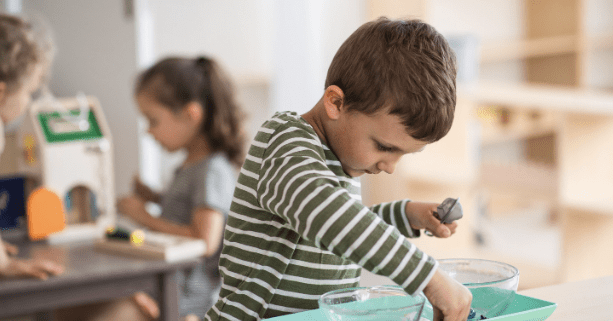As a parent, finding the right educational system for your child is essential. With numerous options available, each coming with its own unique beliefs and approaches to teaching, it can be difficult to decide which one would best suit your needs. Two of these alternatives are Montessori and Waldorf education — noteworthy methods that make learning an enjoyable experience.
In this article, we will explore the differences and similarities between Montessori and Waldorf education and provide recommendations for parents looking for a school for their children.
What is Montessori Education?
Created by Italian physician and educator Maria Montessori in the early 1900s, Montessori education is an educational approach built on the notion that children are natural learners who should be given the room to learn according to their interests and abilities.
Montessori education focuses on hands-on, experiential learning, and encourages children to explore and discover their interests. Classrooms are typically designed to allow children to move freely and work independently. They are also often multi-age, with children of different ages learning and interacting together.
What is Waldorf Education?
Waldorf education is an approach to learning that was developed by Austrian philosopher Rudolf Steiner in the early 20th century. It is based on the idea that education should be holistic and developmental, taking into account the physical, emotional, and spiritual needs of the child.
In a Waldorf classroom, age-appropriate activities such as painting, drawing, music, and storytelling are used to engage children in learning. The emphasis is on creative play and fostering imagination. Classrooms are usually kept simple and natural, with minimal toys or gadgets.
Montessori vs. Waldorf: Differences and Similarities
Knowing the principles and approaches of both Montessori and Waldorf education can help you make an informed decision when selecting a school for your child.
There are several key differences between the two:
Philosophy
Even though both strategies lay strong emphasis on experiential learning and the role of the child, their underlying philosophies diverge. While Montessori education encourages natural curiosity with a focus on independent learning, Waldorf schooling emphasizes holistic advancement through creativity and imagination.
Classroom structure
The Waldorf school system has a structured syllabus, which was designed while keeping in mind the development milestones of each grade. On the other hand, Montessori schools have a curriculum wherein learners direct their own educational journey with access to classroom resources. The teacher holds significant sway over what is presented and taught at Waldorf institutions; conversely, Montessori provides an environment where students take charge of their learning process.
Curriculum
Montessori schools prioritize the teaching of core academic subjects in preschool, while Waldorf schools typically don’t formally introduce these foundational skills until first or second grade.
Despite these differences, there are also several similarities between the two approaches:
Nature
Both Montessori and Waldorf education place a strong emphasis on nature. Both approaches utilize outdoor activities, gardening, art, music, and more to foster a connection with the natural world.
Student-centered learning
Both Montessori and Waldorf schools are designed to be student-centered, meaning that students are encouraged to direct their own learning to some extent.
Individualized instruction
Both Montessori and Waldorf education offer individualized instruction, taking into account the unique needs of each student.
Montessori vs. Waldorf: Recommendations for Parents
Both Waldorf and Montessori schools have their own set of advantages and disadvantages, but deciding which is best for your child largely depends on who they are as an individual.
Consider what kind of learning environment suits them most based on their interests, needs, and personality before making a choice between the two. To help you decide, ask yourself these questions:
- Will your child benefit from having the freedom to direct their own activities and engage in practical work?
- Does your family prioritize outdoor time, such as bike rides or nature hikes, and would like that reflected in your child’s education?
- Is a more structured curriculum with pre-planned learning better suited for them?
If you are interested in learning more about Montessori education, we recommend learning more about or visiting the Montessori schools in the Cadence Education network to explore options. The Cadence Education network also offers numerous other educational schools for your young ones. The perfect school for your child is out there.
Find the Right Partner For Your Child’s Education Through the Cadence Network
Cadence Education is a network of private schools, some with a focus on Montessori-style learning. At Cadence, we know that each child comes to us with unique abilities and interests. Our teachers take the time to get to know each student and develop a personalized learning plan that is tailored specifically to their needs. We are committed to providing children with an education that helps them reach their potential and gain confidence in their own skills.
Cadence Education schools offer a nurturing and supportive environment that encourages creativity, independence, and critical thinking, and are committed to providing a high-quality education for every child.
If you’re looking for an education partner that puts your child’s needs first, then any of the schools in the Cadence Education network may be the right fit for you.
Contact us today to learn more, or find a school near you to schedule a tour.

